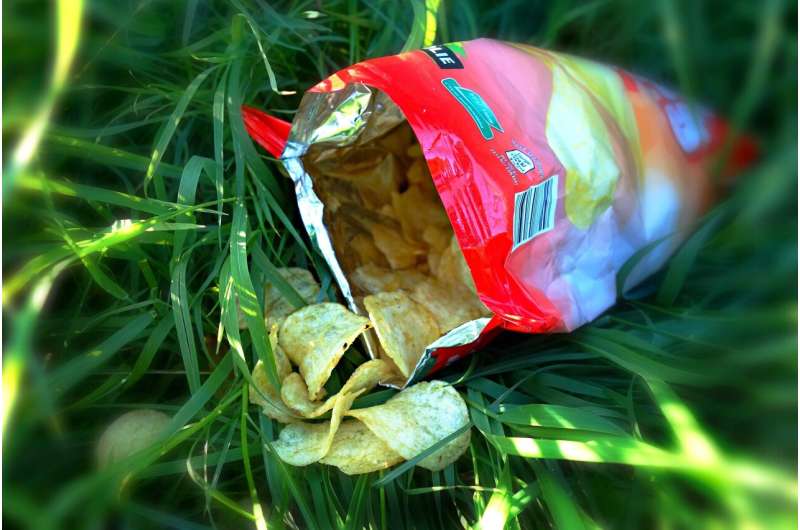This article has been reviewed according to Science X's editorial process and policies. Editors have highlighted the following attributes while ensuring the content's credibility:
fact-checked
peer-reviewed publication
trusted source
written by researcher(s)
proofread
UK teenagers get two-thirds of their calories from ultra-processed foods—new study

Humans have been processing food for thousands of years. While some processing can increase food's safety and shelf-life, consuming lots of ultra-processed foods (UPFs) is linked to health issues such as obesity, high blood pressure, heart disease and type 2 diabetes.
Adults in wealthy countries, such as the UK and the US, get more than half of their calories from UPFs, but adolescents are thought to consume an even higher amount. (Ultra-processed foods include products such as sweetened yogurts, margarine, cereal bars, chicken nuggets and energy drinks.)
Our new study analyzed, for the first time, how much ultra-processed food UK adolescents eat and identified characteristics that were associated with its consumption.
We found that two-thirds of adolescents' calories came from UPFs—the highest proportion for any age group. We also found that more disadvantaged groups consume more of these foods.
We used data from food diaries collected by the UK National Diet and Nutrition Survey between 2008 and 2019. Participants completed the food diaries with all the food and drink they consumed over four days.
We calculated both the percentage of total energy intake and the amount of UPFs consumed in grams. Our study included data from 2,991 adolescents aged 11 to 18. We investigated the relationship between UPF consumption and individual characteristics, such as age, gender, parents' occupation, body weight, ethnic group, region and level of physical activity.
We found that, on average, adolescents consumed 861 grams of UPFs per day, which made up 66% of their daily total energy intake. Our findings also highlight how social inequalities—measured by differences in parents' occupation, sex, ethnicity, region—are associated with the consumption of UPFs.
Younger adolescents consumed more UPFs—for example, 13-year-olds received 68% of their calories from UPFs compared with 63% for 18-year-olds—as did those with parents in different occupations, those of white ethnicity and those living in the north of England. UPFs comprised 68% of adolescents intake in those with parents in "routine and manual occupations," compared with 64% for those with parents in "higher managerial and professional occupations."
Regions made a difference, too. Those in the north of England got 67% of their calories from UPFs, compared with 64% in the south, including London.
But largest difference in consumption was between white and non-white adolescents, where white adolescents got 67% of their calories from UPFs, compared with 59% for non-white adolescents.
Some UPFs, such as diet drinks, have very few calories. So we also looked at UPF grams consumed, which showed similar results to the calorie intake.
Adolescents from more disadvantaged backgrounds, of white ethnicity, not living in the south of England consumed more grams of UPFs than their counterparts. We also found that male adolescents consumed 941 grams of UPFs daily compared with 776 grams for females.
Older teens also consumed more UPFs. For example, 18-year-olds consumed 918 grams compared with 797 grams for 11-year-olds. And adolescents with obesity consumed more UPFs (924 grams) compared to those who weren't obese (841 grams).
We also explored UPFs consumed in each of the survey years.
Our data spanned 11 years, so there were about 300 adolescents who completed food diaries in each year. We found that UPF consumption varied across the years.
In 2008-09, the first year of measurement, adolescents consumed close to 68% of their calories and 996 grams from UPF sources, whereas in 2018-19, the last year of measurement, adolescents consumed fewer calories and grams of UPF per day (65% calories and 776 grams).
Post-pandemic data still needed
However, these figures should be interpreted with caution. They are based on small groups of participants in each year. Until the release of the most recent data, from 2019 onwards, we will not know how UPF consumption has changed since the pandemic.
Addressing the high UPF consumption among adolescents is crucial, as dietary habits formed during this period can persist into adulthood. However, a one-size-fits-all recommendation to reduce UPF consumption may be ineffective or counterproductive, potentially shaming young people and their family food culture.
Instead, involving adolescents in conversations to develop supportive strategies for replacing UPFs with less processed alternatives, improving the quality of food in schools and increasing access and availability of minimally processed foods is essential for fostering healthier dietary habits.
More information: Irazu Yanaina Chavez-Ugalde et al, Ultra-processed food consumption in UK adolescents: distribution, trends, and sociodemographic correlates using the National Diet and Nutrition Survey 2008/09 to 2018/19, European Journal of Nutrition (2024). DOI: 10.1007/s00394-024-03458-z
This article is republished from The Conversation under a Creative Commons license. Read the original article.![]()




















